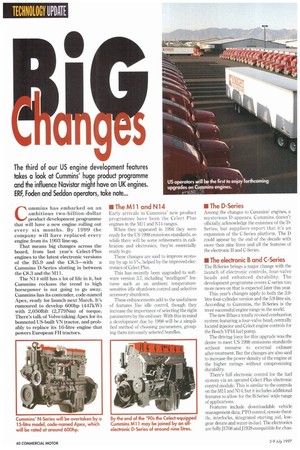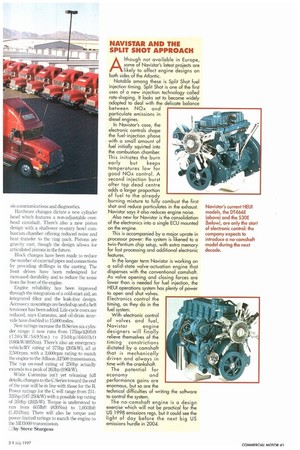The third of our US engine development features takes a
Page 42

Page 43

If you've noticed an error in this article please click here to report it so we can fix it.
look at Cummins' huge product programme and the influence Navistar might have on UK engines. ERF, Foden and Seddon operators, take note...
Cummins has embarked on an ambitious two-billion-dollar product development programme that will have a new engine rolling out every six months. By 1999 the company will have replaced every engine from its 1993 line-up.
That means big changes across the board, from last year's Celect-Plus engines to the latest electronic versions of the B5.9 and the C8.3—with a Cummins D-Series slotting in between the C8.3 and the M11.
The N14 still has a lot of life in it, but Cununins reckons the trend to high horsepower is not going to go away. Cummins has its contender, code-named Apex, ready for launch next March. It's rumoured to develop 600hp (447kW) with 2,0501bft (2,779Nm) of torque. There's talk of Volvo taking Apex for its bonneted US-built VN tractor, and probably to replace its 16-litre engine that powers European FH tractors.
• The M1 1 and N14
Early arrivals in Cummins' new product programme have been the Celect Plus engines in the:1411 and N14 ranges.
When they appeared in 1994 they were ready for the US 1998 emissions standards, so while there will be some refinements in calibration and electronics, they're essentially ready to go.
These changes are said to improve economy by up to 5%, helped by the improved electronics of Celect Plus.
This has recently been upgraded to software version 3.7, including "intelligent" features such as an ambient temperaturesensitive idle shutdown control and selective accessory shutdown.
These enhancements add to the usefulness of features like idle control, though they increase the importance of selecting the right parameters by the end user. With this in mind a development due by 1998 will be a simplified method of choosing parameters, grouping them into easily selected bundles.
• The D-Series
Among the changes to Cummins' engines, a mysterious D appears. Cummins doesn't officially acknowledge the existence of the DSeries, but suppliers report that it's an expansion of the C-Series platform. The D could appear by the end of the decade with more than nine litres and all the features of the electronic B and C-Series.
• The eiedronic B and C-Series
The B-Series brings a major change with the launch of electronic controls, four-valve heads and enhanced durability. The development programme covers C-series too; more news on that is expected later this year.
This year's changes apply to both the 3.9litre four-cylinder version and the 5.9-litre six. According to Cummins, the B-Series is the most successful engine range in the world.
The new B has a totally revised combustion system featuring a four-valve head, centrally located injector and Celect engine controls for the Bosch VP44 fuel pump.
The driving force for this upgrade was the desire to meet US 1998 emissions standards without recourse to external exhaust after-treatment. But the changes are also said to increase the power density of the engine at the higher ratings without compromising durability
There's full electronic control for the fuel system via an uprated Celect Plus electronic control module. This is similar to the controls on the Mll and N14, but it includes additional features to allow for the B-Series' wide range of applications.
Features include downloadable vehicle management data, PTO control, remote throttle, interlocks, integrated starting aid, lowgear derate and water-in-fuel. The electronics arc fully J1708 andJ1939-compatible for chas sis communications and diagnostics.
Hardware changes dictate a new cylinder head which features a non-adjustable overhead camshaft. There's also a new piston design with a shallower re-entry bowl combustion chamber offering reduced noise and heat transfer to the ring pack. Pistons are gravity cast, though the design allows for articulated pistons in the future.
Block changes have been made to reduce the number of external pipes and connections by providing drillings in the casting. The front drives have been redesigned for increased durability and to reduce the noise from the front of the engine.
Engine reliability has been improved through the integration of a cold-start aid, an integrated filter and the leak-free design. Accessory mountings are beefed up and a belt tensioner has been added. Life-cycle costs are reduced, says Cummins, and oil-drain intervals have doubled to 15,000 miles.
New ratings increase the B-Series six-cylinder range: it now runs from 175hp/4201bft (1 3 0 kW/ 569Nm) to 2 5 Ohp/6601bft (186kW/895Nm). There's also an emergency vehicle/RV rating of 275hp (205kW), all at 2,500rpm, with a 2,600rpm rating to match the engine to the Allison AT500 transmission. The top on-road rating of 250hp actually extends to a peak of 263hp (196kW).
While Cummins isn't yet releasing full details, changes to the C-Series toward the end of the year will be in line with those for the B. Power ratings for the C will range from 251335hp (187-250kW) with a possible top rating of 350hp (262kW). Torque is understood to run from 6051bft (820Nm) to 1,050Ibft (1,424Nm). There will also be torque and power-limited ratings to match the engine to the MD3060 transmission.
Li by Steve Sturgess








































































































